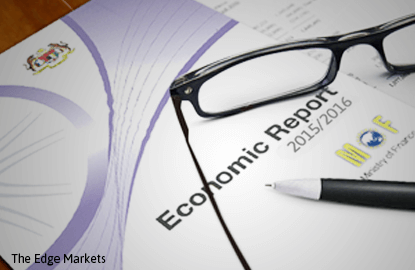
This article first appeared in The Edge Malaysia Weekly, on October 26 - November 1, 2015.
The government is set to post a lower current account surplus for 2015, at 1.5% to 2.5% of gross national income (GNI), due to a weaker ringgit, lower commodity prices and softer external demand.
The government forecasts the surplus will contract further in 2016 to 0.5% to 1.5%, according to the Economic Report 2015/16.
Malaysia recorded a current account surplus of 4.4% of GNI in 2014.
The surplus in the goods and services account is expected to narrow to RM75.1 billion in 2015 from RM102.2 billion recorded a year ago.
The deficit in the services account is expected to widen to RM14.7 billion in 2015, due to a lower surplus in the travel account, at RM29.8 billion. In comparison, 2014 recorded a deficit of RM11.2 billion in the services account, while the travel account surplus was RM33.5 billion.
Travel receipts, the largest contributor to earnings in the services account, are expected to decline by 7.1% to RM68.7 billion, compared with a 9.2% increase to RM74 billion a year ago.
“Despite the gains from a weaker ringgit, the unfortunate airline incidents, natural calamities and security concerns continue to dent tourist arrivals,” states the report.
However, the relaxation of visa requirements for Chinese tourists on group tours from October 2015 to March 2016 is expected to support growth in the tourism industry.
Outbound travel for business, leisure, education and medical treatment is expected to decline 4% to RM38.9 billion due to cautious consumer sentiment on weak purchasing power, compared with a 5% increase to RM40.5 billion in 2014.
The primary income account, consisting of investment income and compensation of employees, is expected to register a smaller deficit of RM33.2 billion in 2015, compared with a RM37.3 billion deficit in 2014.
“This is primarily due to lower repatriation of profits, dividends and interest by foreign investors in Malaysia,” the report says.
However, investment income accruing to foreign investors in Malaysia is expected to decline 10.5% to RM71.2 billion, against an increase of 8.7% to RM79.5 billion a year ago, due to profit margin squeeze and higher operating cost.
Most of the investments, according to the report, are in manufacturing and services, particularly finance, wholesale and retail trade as well as oil and gas.
The deficit in the investment income is expected to narrow to RM27.2 billion, compared with a deficit of RM32.3 billion in 2014.
Net outflows in the secondary income account are expected to be larger, at RM18.5 billion, compared with RM17.6 billion net outflows recorded in 2014, due to higher remittances by foreign workers from Nepal, Myanmar, India, Bangladesh and Indonesia.
The financial account recorded net outflows of RM27.4 billion in the first half of 2015 (1H2015), compared with RM32.4 billion in 2H2014. “This was mainly due to significantly lower net outflows in portfolio investment amid higher investments abroad by Malaysian companies,” the report says.
Outward direct investment was RM27.6 billion in 1H2015, supported by higher extension of inter-company loans by Malaysian companies to their affiliates, mainly for acquisitions in the oil and gas sector. Foreign direct investment (FDI) stood at RM22.4 billion in 1H2015, driven by higher injections of equity capital and reinvestments by multinational companies.
“The main beneficiaries of the FDI were the mining, manufacturing and financial sectors,” the report says, adding that steady inflows are expected, spurred by “confidence in the resilience of the real economy and its growth prospects”.
Save by subscribing to us for your print and/or digital copy.
P/S: The Edge is also available on Apple's AppStore and Androids' Google Play.